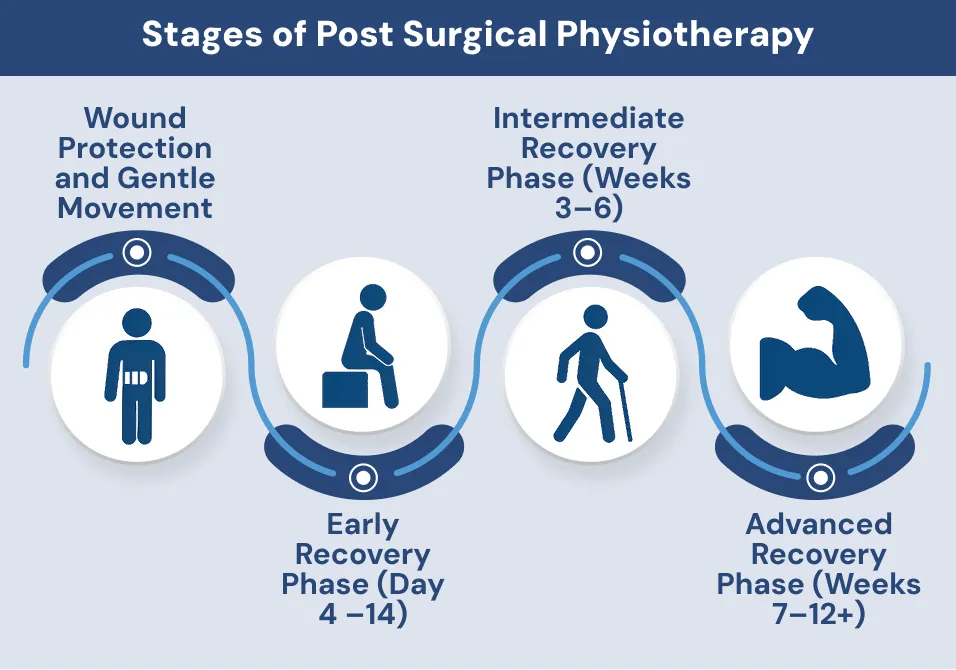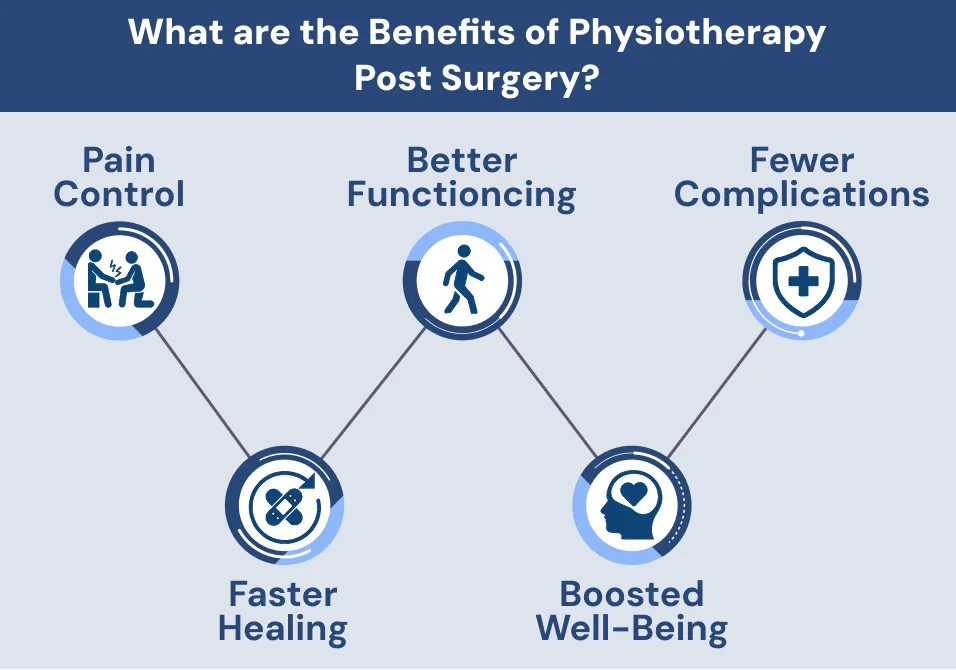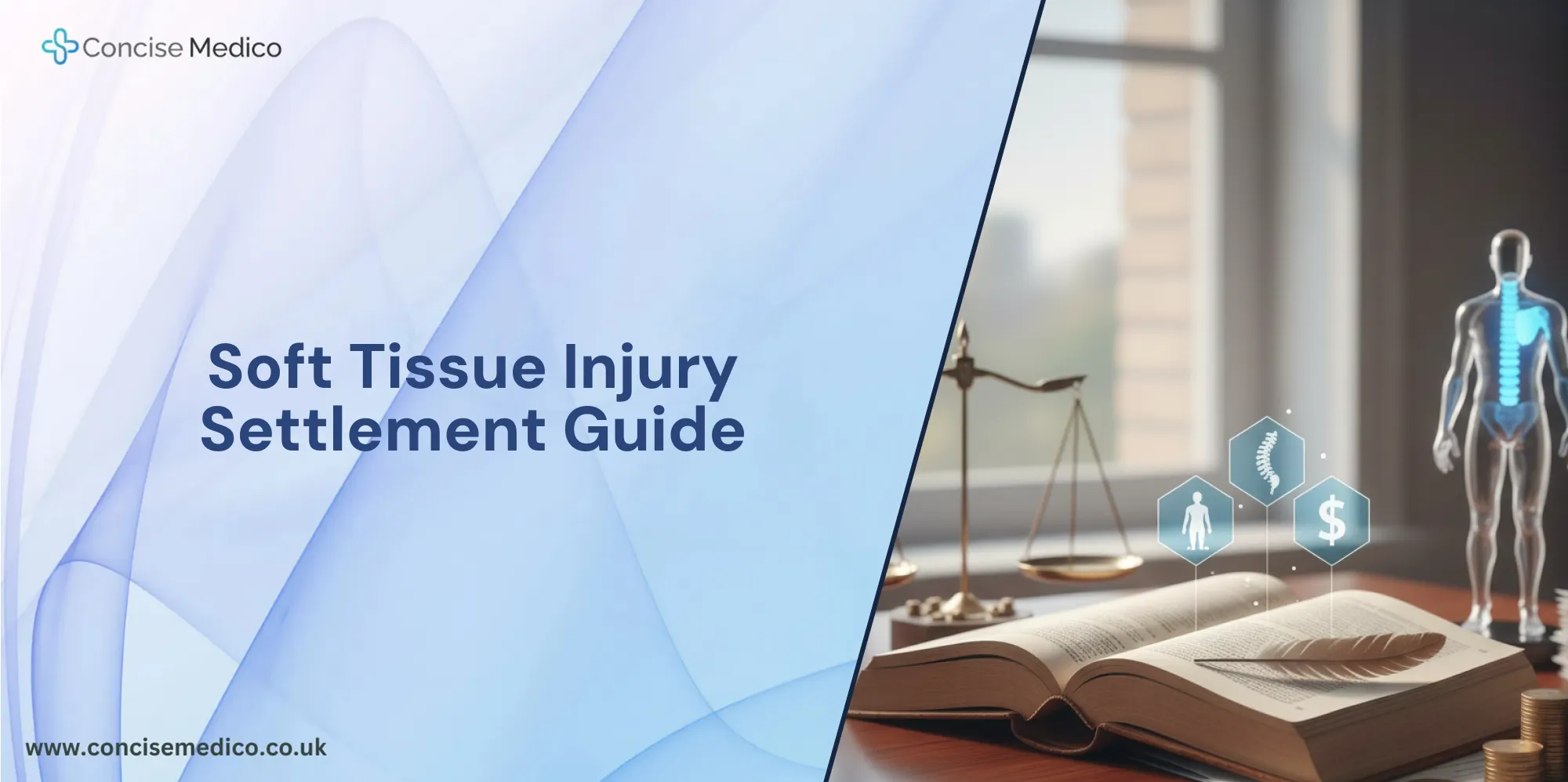TABLE OF CONTENT
Good post surgery rehabilitation can speed your healing. It can ease pain and help you get back to normal life. A clear plan for rehabilitation post surgery makes your path smooth. Early post operative physiotherapy builds strength. It restores movement and lifts your confidence. This guide walks you through each step.
After surgery, ERAS programs for enhanced recovery, or fast track perioperative care, have changed things. Now, the average hospital stay after colorectal cancer surgery is shorter by 30 to 50%. Better post-surgery rehab care helped lower this number. Pre‑Surgery Preparation (Prehab)
Starting physiotherapy before your operation is called “prehab.” It builds muscle tone and teaches key moves. Those moves set you up for post surgical physiotherapy. You will know what to do right after surgery. You will feel more ready and less anxious.
Key Prehab Steps
- Meet your therapist and learn each move until you feel confident.
- Take five deep breaths every hour to help your blood flow.
- Try light band or weight work for the sore area and stop if it hurts.
- Join a group class so you can move with others and feel more at ease.
These steps cut pain and swelling. They prepare you for a successful post surgery rehabilitation. This helps you fully recover later.
Not sure where to begin? See our guide on Choosing Rehabilitation Facility for expert tips.
Stages of Post Surgical Physiotherapy
1. Wound Protection and Gentle Movement
Keep your incision safe. Begin with very light, guided moves. These ease stiffness without pulling the wound. Always wash your hands before you touch the dressing. Change your bandage as your nurse or therapist shows you. If you notice swelling or heat, tell your therapist. Let them know if you feel extra pain.
Passive Mobilisations
Your therapist will move your joint for you. You stay relaxed and let them guide you. This helps stop stiffness and keeps your joint loose. It also brings fresh fluid to help healing. The moves feel gentle and safe. If you feel pain, speak up so they can ease off.
Breathing Exercises
Sit or lie down. Breathe in through your nose until your belly moves out. Breathe out through your mouth until it goes back in. Do this five times every hour. Your chest will relax.

Circulation Drills
Point and flex your feet to pump blood. Do this for one to two minutes each hour. These simple drills boost blood flow and cut clot risk. You can do them lying down or sitting up. Move your toes gently at first. If you see any leg swelling, let your therapist know.
Assistive Devices
Lean on crutches or use a walking frame. Wear your brace as shown by your therapist. These tools reduce stress on healing areas. They also help keep you safe during therapy. Make sure your crutches are set at the right height. Practice small steps at home before moving outside.
2. Early Recovery Phase (Day 4 –14)
Aim to restore the range of motion and begin muscle work.
- Light therapy drills to increase joint movement.
- Simple weight-bearing exercises, if allowed.
- Continued breathing and circulation are working.
- Manual therapy for tight muscles or scar tissue.
3. Intermediate Recovery Phase (Weeks 3–6)
Build strength, endurance, and balance.
- Gradual rehabilitation post surgery with resistance bands.
- Balance drills, such as single‑leg stands.
- Functional moves: sit‑to‑stand, step‑ups.
- Monitor pain and tweak intensity.
4. Advanced Recovery Phase (Weeks 7–12+)
Return to full activity and sport with dedicated post surgery rehabilitation exercises.
- From week 7 to 12, follow post surgery rehabilitation exercises each day.
- These moves rebuild your strength and gently stretch your muscles.
- By week 12, you should feel ready to return to sports and normal activities.
Check out Sports Injury Rehabilitation Best Practices for safe progress
Condition‑Specific Timelines
Each surgery type has its own post surgery rehabilitation map. Tailor your plan to your procedure:
| Surgery Type | Mobilisation Day | Home‑Exercise Start | Full Activity Return |
|---|---|---|---|
| Knee replacement | Day 1 | Week 2 | Week 12–16 |
| Hip replacement | Day 1 | Week 1 | Week 10–14 |
| Spinal surgery | Day 2 | Week 3 | Week 12–24 |
| Cardiac surgery | Day 1 | Week 1 | Week 8–12 |
Providing a clear plan helps set real goals.
Home‑Exercise Resources
Visual aids and handouts can boost adherence. Offer:
- PDF sheets with photos of each exercise.
- Short video clips showing proper form.
- A simple log to track daily progress.
Downloadable sheets cut confusion and improve safety.
What are the Benefits of Physiotherapy Post Surgery?
Pain Control
Manual techniques and guided moves help reduce pain in post surgery rehabilitation. They do this without relying on heavy drugs.
Cryotherapy
In this, ice packs on the area for 10–15 minutes cut swelling. They numb sore spots and slow inflammation.
Thermotherapy
Before exercise, heat pads are used in therapy to loosen tight muscles. They boost blood flow and ease stiffness.
Electrotherapy
In post surgery rehabilitation, low‑level electrical pulses block pain signals. They also aid cell repair and reduce discomfort.
Learn strategies for Chronic Pain Rehabilitation.

Faster Healing
- Early movement in rehabilitation post surgery speeds tissue repair.
- Massaging scar tissue stops tight spots from forming.
- Gentle weight‑bearing work helps bone and muscle grow strong.
Better Functioning
- Regained strength and motion from post surgery physiotherapy help with daily tasks.
- Sit‑to‑stand exercises make getting on and off the toilet easier.
- Stair drills build confidence for home steps and curbs.
“Hospital services, such as physical therapy (PT), are routinely utilised to promote recovery and reduce functional declination.”
Adogwa et al.
Fewer Complications
- Proper post operative physiotherapy cuts risks of clots and lung issues.
- Circulation drills ward off deep vein thrombosis.
- Breathing exercises lower the chances of chest infections.
Boosted Well‑Being
- Doing well in physiotherapy after surgery makes you feel happier and more confident.
- Logging small wins keeps you motivated each day.
- Joining group sessions provides extra support and a social boost.
Expert Tips and Recommendations
- Move a little two days after surgery. It often makes it hurt less.
- Pick one small aim each week, like lifting your foot a bit higher.
- Split your rehab into tiny steps you can finish in a day.
- Lean on crutches or wear your brace just as your therapist showed.
- Spend a few minutes on your home moves every day.
- If your swelling or hurt jumps up, tell your therapist right away.
Challenges in Post Surgery Rehabilitation
Moving again after surgery can be harder than it sounds. You may feel pain even in small steps. Your knee or shoulder might swell more some days. You can wake up stiff after sleep. Low energy and mood dips can sneak in. Worry about bending wrong may slow you down. Skipping exercises feels tempting when progress stalls. Try to mark each small win with a check. Keep your post surgery rehabilitation notes in view. Reach out to your therapist when you hit a wall. Small, steady steps will add up.
Start Your Post Surgery Rehabilitation
A tailored post surgery rehabilitation plan is vital. It mixes hands-on care, guided exercises, and home drills. Timelines show you what to do and when. Visual aids and real‑life examples keep you on track. Seek expert help and stick to a best therapy routine. This will make your recovery safer and faster. Team up with a qualified therapist for a plan that fits you.
Start your post surgery rehabilitation with Concise Medico today.
Reach out to Concise Medico to set up your plan. We design a custom post operative physiotherapy program just for you.
Our physio experts services will guide each step. You’ll get stronger, move easier, and return to daily life with confidence.
FAQs
Good post surgery rehabilitation can speed your healing. It can ease pain and help you get back to normal life. A clear plan for rehabilitation post surgery makes your path smooth. Early post operative physiotherapy builds strength. It restores movement and lifts your confidence. This guide walks you through each step.
After surgery, ERAS programs for enhanced recovery, or fast track perioperative care, have changed things. Now, the average hospital stay after colorectal cancer surgery is shorter by 30 to 50%. Better post-surgery rehab care helped lower this number. Pre‑Surgery Preparation (Prehab)
Starting physiotherapy before your operation is called “prehab.” It builds muscle tone and teaches key moves. Those moves set you up for post surgical physiotherapy. You will know what to do right after surgery. You will feel more ready and less anxious.
Key Prehab Steps
- Meet your therapist and learn each move until you feel confident.
- Take five deep breaths every hour to help your blood flow.
- Try light band or weight work for the sore area and stop if it hurts.
- Join a group class so you can move with others and feel more at ease.
These steps cut pain and swelling. They prepare you for a successful post surgery rehabilitation. This helps you fully recover later.
Not sure where to begin? See our guide on Choosing Rehabilitation Facility for expert tips.
Stages of Post Surgical Physiotherapy
1. Wound Protection and Gentle Movement
Keep your incision safe. Begin with very light, guided moves. These ease stiffness without pulling the wound. Always wash your hands before you touch the dressing. Change your bandage as your nurse or therapist shows you. If you notice swelling or heat, tell your therapist. Let them know if you feel extra pain.
Passive Mobilisations
Your therapist will move your joint for you. You stay relaxed and let them guide you. This helps stop stiffness and keeps your joint loose. It also brings fresh fluid to help healing. The moves feel gentle and safe. If you feel pain, speak up so they can ease off.
Breathing Exercises
Sit or lie down. Breathe in through your nose until your belly moves out. Breathe out through your mouth until it goes back in. Do this five times every hour. Your chest will relax.

Circulation Drills
Point and flex your feet to pump blood. Do this for one to two minutes each hour. These simple drills boost blood flow and cut clot risk. You can do them lying down or sitting up. Move your toes gently at first. If you see any leg swelling, let your therapist know.
Assistive Devices
Lean on crutches or use a walking frame. Wear your brace as shown by your therapist. These tools reduce stress on healing areas. They also help keep you safe during therapy. Make sure your crutches are set at the right height. Practice small steps at home before moving outside.
2. Early Recovery Phase (Day 4 –14)
Aim to restore the range of motion and begin muscle work.
- Light therapy drills to increase joint movement.
- Simple weight-bearing exercises, if allowed.
- Continued breathing and circulation are working.
- Manual therapy for tight muscles or scar tissue.
3. Intermediate Recovery Phase (Weeks 3–6)
Build strength, endurance, and balance.
- Gradual rehabilitation post surgery with resistance bands.
- Balance drills, such as single‑leg stands.
- Functional moves: sit‑to‑stand, step‑ups.
- Monitor pain and tweak intensity.
4. Advanced Recovery Phase (Weeks 7–12+)
Return to full activity and sport with dedicated post surgery rehabilitation exercises.
- From week 7 to 12, follow post surgery rehabilitation exercises each day.
- These moves rebuild your strength and gently stretch your muscles.
- By week 12, you should feel ready to return to sports and normal activities.
Check out Sports Injury Rehabilitation Best Practices for safe progress
Condition‑Specific Timelines
Each surgery type has its own post surgery rehabilitation map. Tailor your plan to your procedure:
| Surgery Type | Mobilisation Day | Home‑Exercise Start | Full Activity Return |
|---|---|---|---|
| Knee replacement | Day 1 | Week 2 | Week 12–16 |
| Hip replacement | Day 1 | Week 1 | Week 10–14 |
| Spinal surgery | Day 2 | Week 3 | Week 12–24 |
| Cardiac surgery | Day 1 | Week 1 | Week 8–12 |
Providing a clear plan helps set real goals.
Home‑Exercise Resources
Visual aids and handouts can boost adherence. Offer:
- PDF sheets with photos of each exercise.
- Short video clips showing proper form.
- A simple log to track daily progress.
Downloadable sheets cut confusion and improve safety.
What are the Benefits of Physiotherapy Post Surgery?
Pain Control
Manual techniques and guided moves help reduce pain in post surgery rehabilitation. They do this without relying on heavy drugs.
Cryotherapy
In this, ice packs on the area for 10–15 minutes cut swelling. They numb sore spots and slow inflammation.
Thermotherapy
Before exercise, heat pads are used in therapy to loosen tight muscles. They boost blood flow and ease stiffness.
Electrotherapy
In post surgery rehabilitation, low‑level electrical pulses block pain signals. They also aid cell repair and reduce discomfort.
Learn strategies for Chronic Pain Rehabilitation.

Faster Healing
- Early movement in rehabilitation post surgery speeds tissue repair.
- Massaging scar tissue stops tight spots from forming.
- Gentle weight‑bearing work helps bone and muscle grow strong.
Better Functioning
- Regained strength and motion from post surgery physiotherapy help with daily tasks.
- Sit‑to‑stand exercises make getting on and off the toilet easier.
- Stair drills build confidence for home steps and curbs.
“Hospital services, such as physical therapy (PT), are routinely utilised to promote recovery and reduce functional declination.”
Adogwa et al.
Fewer Complications
- Proper post operative physiotherapy cuts risks of clots and lung issues.
- Circulation drills ward off deep vein thrombosis.
- Breathing exercises lower the chances of chest infections.
Boosted Well‑Being
- Doing well in physiotherapy after surgery makes you feel happier and more confident.
- Logging small wins keeps you motivated each day.
- Joining group sessions provides extra support and a social boost.
Expert Tips and Recommendations
- Move a little two days after surgery. It often makes it hurt less.
- Pick one small aim each week, like lifting your foot a bit higher.
- Split your rehab into tiny steps you can finish in a day.
- Lean on crutches or wear your brace just as your therapist showed.
- Spend a few minutes on your home moves every day.
- If your swelling or hurt jumps up, tell your therapist right away.
Challenges in Post Surgery Rehabilitation
Moving again after surgery can be harder than it sounds. You may feel pain even in small steps. Your knee or shoulder might swell more some days. You can wake up stiff after sleep. Low energy and mood dips can sneak in. Worry about bending wrong may slow you down. Skipping exercises feels tempting when progress stalls. Try to mark each small win with a check. Keep your post surgery rehabilitation notes in view. Reach out to your therapist when you hit a wall. Small, steady steps will add up.
Start Your Post Surgery Rehabilitation
A tailored post surgery rehabilitation plan is vital. It mixes hands-on care, guided exercises, and home drills. Timelines show you what to do and when. Visual aids and real‑life examples keep you on track. Seek expert help and stick to a best therapy routine. This will make your recovery safer and faster. Team up with a qualified therapist for a plan that fits you.
Start your post surgery rehabilitation with Concise Medico today.
Reach out to Concise Medico to set up your plan. We design a custom post operative physiotherapy program just for you.
Our physio experts services will guide each step. You’ll get stronger, move easier, and return to daily life with confidence.




